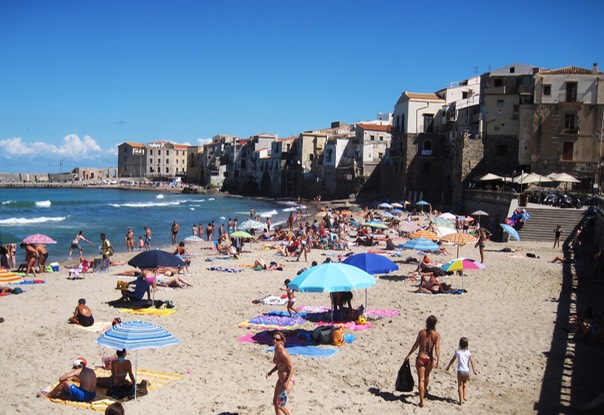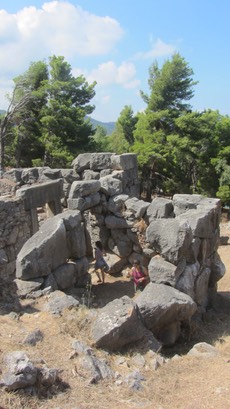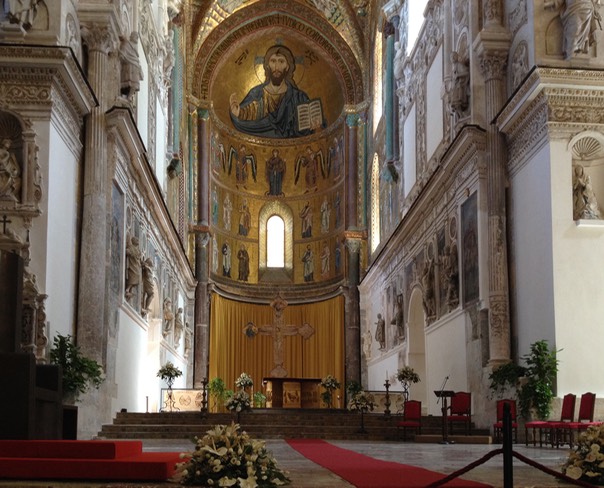
Florence, Verona, Venice and Rome were always compulsory destinations on any Grand Tour, yet Sicily’s even greater cultural antiquity initially proved less attractive for protestant Northern Europeans as Spanish control brought the Inquisition to the island.
Inigo Jones, followed by Lord Burlington, and Robert Adam toured northern Italian antiquities popularising Palladian and Classical architecture throughout the UK. But later, Scotsman Patrick Brydone's best-selling journals on "Sicily and Malta", together with Henry Swinburne's volumes, eventually drew Grand Tourists further south.

Sicily remains extraordinarily rich in cultural monuments. Even tiny Cefalu on the north coast close to Palermo still displays ancient origins. Sited defensively atop the steep 'Rocco', ruins of a Saracen Castle and Doric Temple of Diana reward the climber. Best preserved is a Cyclopian domestic building constructed dry from gigantic limestone boulders but with decorative mouldings and carved doorways. Substantial lengths of the defensive walls from the fourth century BC still surround this high plain providing a dynamic profile.
Cefalu relocated to its present site at the foot of the rock in 1131 when Sicily's King Roger II established the present Duomo and harbour. Two similar - but not identical towers - frame the Doumo’s entrance and dominate the skyline. Yet this Norman Cathedral provides still greater interest internally. Roman and Corinthian columns support Arab influenced arches, spanning bright golden mosaics illuminating the space.
Narrow mediaeval streets still connect through irregular 'squares' celebrating nodes en route to the Duomo and the harbour. Airy pends open through to the beach and waterfront, one still accessing the medieval 'lavatoio' - open air laundry.
Cafes and restaurants permeate orderly facades and lead through to multi-level dining platforms stretching out across the rocky foreshore. Twinkling lights and candles on dark Sicilian evenings transform simple timber and scaffolding into a glamorous stage set for this gastronomic theatre. This busy bustle illuminates oversailing "ad hoc" rear elevations where numerous improbable apartment extensions appear to defy gravity.

Throughout Sicily architecture is sculptural playing with light and texture, development may be organic but is orderly and consistent, and long human habitation is evident everywhere. For a time touring educated young aristocrats by exposing them to classical culture, art, music and the Renaissance, stimulating generations of Neoclassicism and Greek revivalism throughout Georgian and Victorian Britain.
The discovery of Pompeii and Herculaneum in the mid 18th century effectively redirected attention from art towards science, archeology and volcanoes . Coincidentally recreational travel became restricted by Napoleon’s Italian Invasion and by the time peace was restored Thomas Cook was offering a radically different and less 'grand' touring concept.
Late Grand Tourists apparently developed a taste for macaroni, then unknown in Britain, and on their return home this pasta, like the architecture before it, briefly became synonymous with high fashion and style. Thus 'macaroni' entered English language as an adjective - with superlatives 'very macaroni', - even spawning an informal "Macaroni Club" for London's highest society.
Inevitably "macaroni" became a pejorative term implying dandi-ism or ridicule. Yet, this tiny sliver of Italian food culture remains ubiquitous throughout the British Isles and now probably provides a more recognisable cultural legacy than all the art, music and architecture. C’est la vie!
522 words.